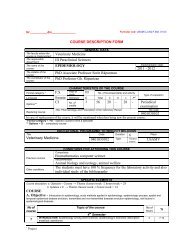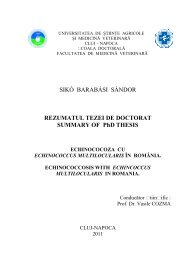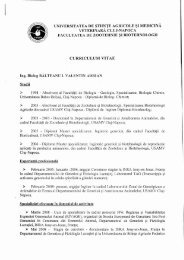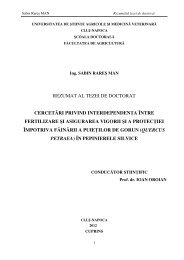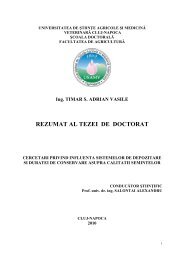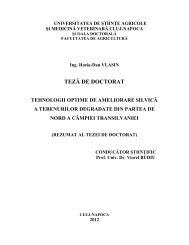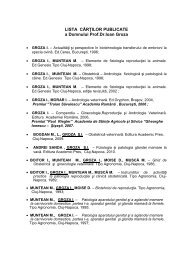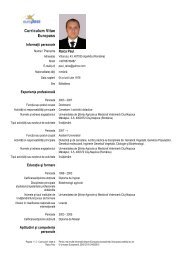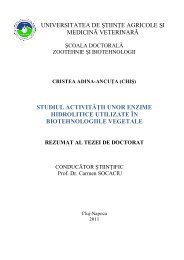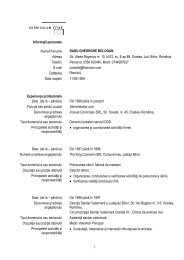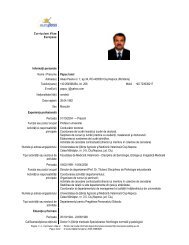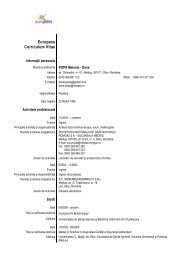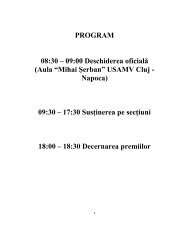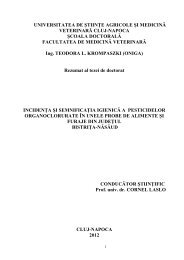Rezumatul tezei de doctorat - USAMV Cluj-Napoca
Rezumatul tezei de doctorat - USAMV Cluj-Napoca
Rezumatul tezei de doctorat - USAMV Cluj-Napoca
You also want an ePaper? Increase the reach of your titles
YUMPU automatically turns print PDFs into web optimized ePapers that Google loves.
We mention the fact that in al the analyzed fisheries there is applied the annual<br />
disinfection, in the fishponds where the natural supervised reproduction takes place,<br />
emptying and keeping them dry on the winter period. Before the filling, the fishponds are<br />
disinfected with lime at all of their surface. With all this, because of the reproduction<br />
individuals manipulation and of the vegetation massive <strong>de</strong>velopment, in the reproduction<br />
period there are <strong>de</strong>scribed strong attacks of pathogenic fungi upon spawns, with losses up to<br />
70% in Ariniş fishery, and in the fisheries where the hygienic measures are very severe, the<br />
losses are up to 20% from affected spawns (Cefa location). In average, in the 69 fishponds<br />
from the 10 locations studied, the cyprinid spawn losses raise up to 41,10%. The larval<br />
period, specially the first 3 days of life one, when their movements are limited by the<br />
presence of vitelline membrane, the average losses raise up to 16,70%, with a 30%<br />
maximum of losses, in Ariniş fishery, and a 5% minimum of losses in Cefa fishery. The<br />
alevin period, extremely difficult as needs of water oxygen level and food quality, is strong<br />
affected by saprolegniasis. The average losses of 7,60%, are more reduced compared to the<br />
larval period. The biggest losses percentage at this category of age, is encountered in Iernut<br />
fishery (13%), and a minimum of 5% in Ariniş, Ciurila, Daia, Cefa fishries.<br />
In the young fish period, with its particular attention gived by the fishery owners<br />
regarding the water and food quality, when there is assured an optimal <strong>de</strong>nsity of the<br />
individuals and the manipulations restricted, the losses caused by saprolegniasis are more<br />
reduced, being in average of 4,90%.<br />
The adult period is not safe from Saprolegnia attack. In the majority of the studied<br />
fisheries, there is practiced the autumn fishing and the transfer of the kept fish for the next<br />
year, in the wintering fishponds. The manual labor of catching, transportation and<br />
repopulation in another fishpond causes body and fishfins inherent wounds. On the winter<br />
period, the fish do not eat any food, their organism being weakened, and un<strong>de</strong>r the<br />
influences of sud<strong>de</strong>n temperature changes and ice layer, the losses are in average of 6,30%.<br />
In springtime, the reproducers, as well as the fish kept for breeding, are verified regarding<br />
their state maintenance and health, using fishing nets. The manipulation produces wounds,<br />
which are causing the increase of saprolegniasis inci<strong>de</strong>nce, the average of the losses being of<br />
71



